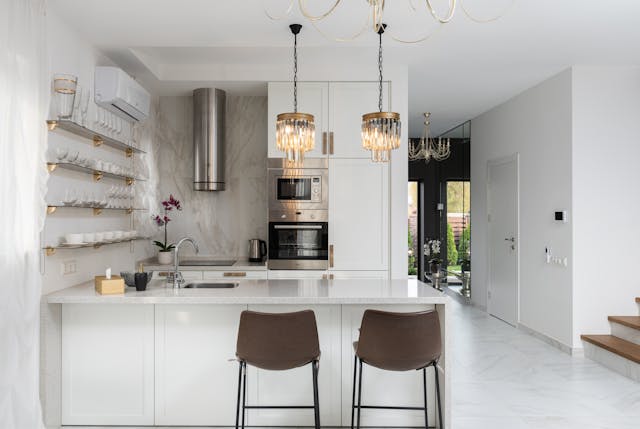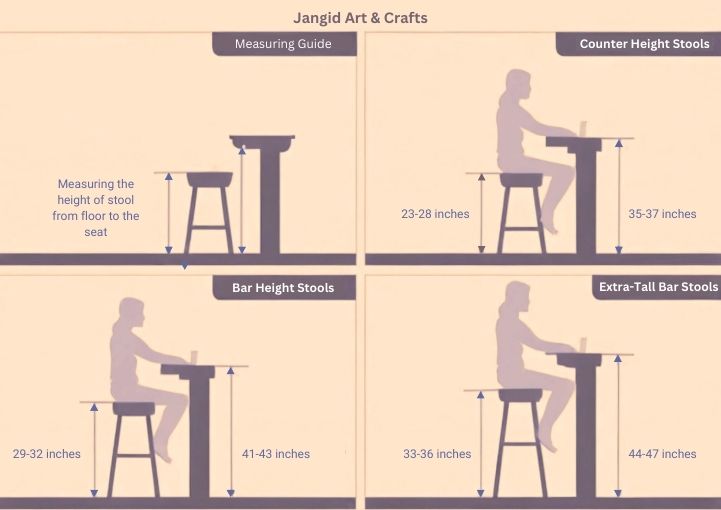How to Choose Bar Stool Height Secrets: Never Choose the Wrong Size Again!

Table of Contents
Choosing the right bar stool height can feel like a puzzle, but once you get it right, your space will shine with comfort and style. Finding the perfect bar stool height is key, whether you’re setting up a cozy kitchen island, a lively home bar, or even a chic outdoor spot. Let’s dive into what you need to know to make the best choice.
Understanding How to Choose Bar Stool Height
Bar stools come in different heights, and each type serves a specific purpose. Here’s a quick rundown:
- Counter Height Stools (23-28 inches): These stools fit perfectly with kitchen counters, islands, and taller dining tables that stand 35-37 inches high. They’re the perfect match for those quick breakfasts or casual chats.
- Bar Height Stools (29-32 inches): Ideal for bars or higher counters that range from 41-43 inches in height. They’re a bit taller, giving you that classic bar vibe.
- Extra-Tall Bar Stools (33-36 inches): Also known as “spectator stools,” these are the giants of the bar stool world. They’re made for bars that are 44-47 inches high, perfect if you want to feel like royalty overlooking your domain.

Fun Fact: Bar height stools are a hot favorite, making up over 50% of bar stool sales last year. Home bars and kitchen islands are where the action’s at!
Measuring for the Perfect Fit
Let’s get into the numbers. You’ll need to do a little measuring to find the right bar stool height, but don’t worry—it’s a breeze!
- Measure Your Counter Height: Grab a tape measure and check the distance from the floor to the top of your counter or bar. This number is your starting point.
- Calculate the Seat Height: Subtract 10-12 inches from your counter height, and voilà, you’ve got the ideal seat height. This gap ensures you’ve got enough legroom to sit comfortably and swing those legs. Example: Got a 36-inch counter? A seat height of 24-26 inches will hit the sweet spot.
- Consider Legroom: Make sure there’s at least 10 inches of space between the stool seat and the underside of the counter. This space keeps you from feeling cramped.
Pro Tip: If your countertop is thicker than a celebrity’s Instagram filter, you might need a slightly taller stool to keep that 10-12 inch gap.
For Specific Counter Height Examples:

- For a 35-inch counter: Choose stools with a seat height of 23-25 inches.
- For a 36-inch counter: Go for stools with a seat height of 24-26 inches.
- For a 42-inch counter: Select bar stools with a seat height of 30-32 inches.
- For a 48-inch counter: Opt for extra-tall bar stools with a seat height of 36-38 inches.
- For a 90cm (35.4-inch) counter: Choose stools with a seat height of 23-25 inches, similar to a 35-inch counter.
Choosing Between Bar and Counter Stools
Here’s the deal: the main difference between bar and counter stools is their height. Knowing which to choose can make all the difference in comfort and style.
- Counter Stools: If your space has kitchen counters, islands, or tall dining tables standing 35-37 inches high, go with counter stools. They’re great for casual meals and morning coffee.
- Bar Stools: These are your go-to’s for bars, pub tables, or any counter that stands between 41-43 inches tall. They’re taller, giving you that elevated experience.
- Adjustable Stools: For those who love versatility, adjustable stools are a must-have. They let you change the height to suit different moods or users, making them perfect for any occasion.
Did You Know? Adjustable stools are becoming a kitchen staple, thanks to the trend toward multi-functional spaces. They’re the chameleons of the furniture world, adapting to whatever you need.
Comfort Considerations
When it comes to bar stools, comfort is non-negotiable. You want to enjoy your time sitting down, not counting the seconds until you can stand up again. Here’s what to look for:
- Ergonomic Design: Go for stools with a contoured seat and backrest. Your back and backside will thank you after a long dinner or extended happy hour.
- Footrests: A well-placed footrest is a game-changer. It keeps your legs and back from getting tired, so you can sit comfortably for longer.
- Padded Seats: For that extra layer of comfort, padded seats are the way to go. They’re especially great if you’re planning on spending a lot of time sitting.
Survey Says: A whopping 72% of homeowners pick comfort over looks when buying bar stools. It just goes to show, nobody likes a sore bum!
Spacing and Arrangement
Arranging your stools is like setting up a party—get the spacing right, and everyone’s happy.
- Distance Between Stools: Give each stool its space! Leave 6-10 inches between stools for bar seating and about 15 inches for dining setups. This way, no one’s elbowing their neighbor for room.
- Knee Space: Make sure there’s 10-12 inches of space between the stool seat and the counter. This gives you plenty of room to get in and out without bumping your knees.
Pro Tip: Got a crowd coming over? Go for stools that can be easily moved or tucked away to free up space when needed.
Common Mistakes to Avoid
Don’t trip up on these common mistakes when picking your bar stools:
- Ignoring Counter Thickness: If your countertop is extra thick, you might need a taller stool to keep that legroom just right.
- Choosing the Wrong Height: Too tall or too short, and you’re in for an uncomfortable experience. Measure carefully, and double-check before you buy.
- Overcrowding: Packing stools too close together makes your space feel cramped. Stick to the spacing guidelines to keep things comfy and inviting.
Statistic Alert: 40% of people end up choosing stools that don’t match their counter height, leading to awkward seating and frustrating returns. Don’t be one of them!
Design and Aesthetic Integration
Your bar stools should be more than just functional—they should add style to your space. Here’s how to make sure they fit right in:
- Material and Finish: Pick stools that match the style of your room. Metal or acrylic stools work well for modern spaces, while wooden stools are perfect for traditional or rustic settings.
- Color Coordination: Keep your room’s color palette in mind. Neutral tones are versatile and timeless, while bold colors can make your stools the stars of the room.
- Design Details: Pay attention to the little things like the shape of the seat, the style of the legs, and any decorative elements. These details add character and can really make your space pop.
Fun Fact: The top trend for 2024? Minimalist designs with clean lines and neutral tones. It’s all about keeping things simple and stylish.
Specialty Stools for Unique Needs
Sometimes, standard bar and counter stools just won’t cut it. Here’s when you might need something special:
- Vanity Stools: These are lower and perfect for a dressing table. They usually have a seat height of 18-20 inches, just right for primping and prepping.
- Stools for Kids: Safety first! These stools are lower and often come with backrests and armrests to keep the little ones safe and comfy.
- Extra-Tall Stools: If your bar is sky-high, you’ll need extra-tall stools. With seat heights from 33-36 inches, they’re perfect for outdoor bars or tall tables.
Industry Insight: Specialty stools are trending, especially in homes with multi-purpose spaces. More and more people are investing in stools that cater to their unique needs.
Maintenance and Care for Bar Stools
Once you’ve found the perfect bar stools, you’ll want to keep them looking sharp. Here’s how:
- Regular Cleaning: Wipe down your stools with a mild soap and water mix. Steer clear of harsh chemicals that could damage the finish.
- Tighten Screws and Bolts: Give your stools a once-over every so often to tighten any loose screws or bolts. This keeps them sturdy and safe.
- Replace Worn Parts: If any part of the stool gets worn or damaged, replace it ASAP. This keeps your stools looking great and working well.
Pro Tip: Investing in high-quality stools made from durable materials might cost more upfront, but it’ll save you money in the long run by lasting longer and needing less maintenance.
Final Thoughts
Choosing the right bar stool height isn’t just about picking something that looks good. It’s about finding that perfect blend of comfort, style, and functionality. By following this guide, you’ll be ready to select stools that not only look amazing but also make your space more inviting. Whether you’re furnishing a kitchen island, a home bar, or a patio, the perfect stool is out there waiting to elevate your space.
Now, go find your perfect bar stool—and get ready to sit in style!
Faq’s
1. What is the standard height for bar stools?
The standard height for bar stools is 29-32 inches, suitable for counters 41-43 inches tall.
2. What is the best height for a kitchen bar stool?
The best height for standard kitchen counters (35-37 inches) is 23-28 inches.
3. What is the average height of a stool?
The average height varies based on use:
Counter stools: 23-28 inches
Bar stools: 29-32 inches
Extra-tall stools: 33-36 inches
4. What height bar stool for a 90cm counter?
For a 90cm (35.4-inch) counter, choose stools with a seat height of 23-25 inches.
5. What is the Bar stool height for a 42-inch counter?
For a 42-inch counter, choose bar stools with 30-32 inches seat height.
6. What is the stool height for a 36” counter?
For a 36-inch counter, the ideal stool height is 24-26 inches.
7. What is the Bar stool height for a 48-inch counter?
For a 48-inch counter, opt for extra-tall bar stools with a seat height of 36-38 inches.
8. How much space should I leave between bar stools?
Leave 6-10 inches between bar stools for comfortable seating.
9. How many inches should be between the bar stool and the counter?
Aim for 10-12 inches between the stool seat and the underside of the counter for proper legroom.
10. How far apart should bar stools be in a restaurant?
Leave 26-30 inches in restaurants from the center of one stool to the center of the next for optimal spacing and comfort.
One thought on “How to Choose Bar Stool Height Secrets: Never Choose the Wrong Size Again!”